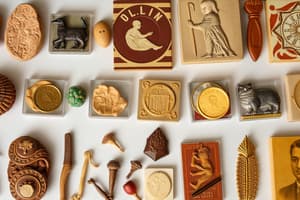Podcast
Questions and Answers
Describe the difference between class characteristics and individual characteristics of evidence.
Describe the difference between class characteristics and individual characteristics of evidence.
Class characteristics describe traits of evidence that allow comparison with a group, while individual characteristics allow comparison with a specific object or person.
Of the available methods for DNA analysis, which is the best for individualization in forensic work and why?
Of the available methods for DNA analysis, which is the best for individualization in forensic work and why?
- PCR
- Mitochondrial DNA
- STR (correct)
- RFLP
Describe how tape is used to collect hair and fiber evidence at the crime scene.
Describe how tape is used to collect hair and fiber evidence at the crime scene.
Special tape is placed on the surface and collected in sections, then placed sticky side down on transparent paper.
When evaluating glass fractures for direction of force, which fragments can be used in the evaluation?
When evaluating glass fractures for direction of force, which fragments can be used in the evaluation?
How is paint layering used to differentiate two paint samples?
How is paint layering used to differentiate two paint samples?
What are some significant forms of environmental variation in soil sample comparison?
What are some significant forms of environmental variation in soil sample comparison?
How would evaluating crime scene evidence involving a pistol differ from that involving a revolver?
How would evaluating crime scene evidence involving a pistol differ from that involving a revolver?
What does rifling refer to in terms of barrel components?
What does rifling refer to in terms of barrel components?
How are bullets marked for evidence and why?
How are bullets marked for evidence and why?
Of the two methods used to collect tool mark evidence, which is better and why?
Of the two methods used to collect tool mark evidence, which is better and why?
What is the most significant class characteristic in shoe mark examinations and why?
What is the most significant class characteristic in shoe mark examinations and why?
What type of containers are used to collect fire scene evidence believed to have accelerants?
What type of containers are used to collect fire scene evidence believed to have accelerants?
What is the difference between forged and traced writing in forensic analysis?
What is the difference between forged and traced writing in forensic analysis?
What is the most appropriate response by the crime scene technician for collecting a computer for forensic analysis?
What is the most appropriate response by the crime scene technician for collecting a computer for forensic analysis?
Flashcards are hidden until you start studying
Study Notes
Class vs. Individual Characteristics
- Class characteristics allow comparison within a group (e.g., type of shoe or tire), while individual characteristics can link evidence to a specific source (e.g., unique scratches on a tool).
DNA Analysis Methodology
- STR (Short Tandem Repeat) method is most effective for forensic individualization, enabling analysis from minimal DNA samples and providing a differentiation chance of 1 in 6 billion.
Tape Collection Technique
- Specialized tape is used to gather hair and fiber evidence, applied section by section until less tacky, then pressed onto transparent paper for analysis. Different areas require separate sheets.
Glass Fracture Evaluation
- Radial fractures within the first concentric rings are crucial for determining the direction of force, while fragments in subsequent concentric layers reduce accuracy of analysis.
Paint Layering Analysis
- Differentiation of paint samples depends on layers of primers, base coats, and clear coats, especially in cases involving paint chips from vehicles in hit-and-run incidents.
Soil Sample Comparison
- Variation in soil samples focuses on mineral content, environmental contamination, and pollen types, with pollens providing the most significant differentiation.
Firearm Evidence Evaluation
- Revolvers and pistols have distinct evidence patterns; revolvers create gunshot residue patterns due to the cylinder gap, while pistols utilize a preloaded magazine and have different fingerprint locations.
Gun Barrel Components
- Rifling in gun barrels consists of lands (raised portions) and grooves (depressions), critical for bullet trajectory analysis.
Bullet Evidence Packaging
- Bullets should be kept in hard containers to prevent contact damage, while shotgun pellets can be packaged together due to their uniformity not leaving distinct marks.
Tool Mark Evidence Collection
- Collecting the entire tool is preferred over casting for tool mark evidence due to potential microscopic variations that casting may overlook.
Shoe Mark Examination
- Tread design is a key class characteristic in shoe mark analysis, facilitating identification through extensive databases cataloging various shoe brands and types.
Fire Scene Evidence Collection
- Arson bags, double-sealed, are critical for collecting evidence of accelerants to prevent vapor escape, unlike plastic bags.
Forged vs. Traced Writing
- Forged writing involves identifying a writer based on an original piece found at a scene, while traced writing lacks the natural fluidity of genuine signatures, making it non-attributable to any writer.
Collecting Computer Evidence
- Technicians should consult a computer crime team for proper procedures when seizing computers, including documenting actions, photographing setups, and labeling cables for accurate reassembly.
Studying That Suits You
Use AI to generate personalized quizzes and flashcards to suit your learning preferences.




